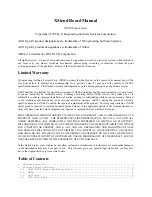
Listing 2:
Connections between the XStend LEDs and the XS95.
# LEFT LED DIGIT SEGMENT CONNECTIONS (ACTIVE-LOW)
NET LS_0
LOC=P1;
NET LS_1
LOC=P2;
NET LS_2
LOC=P3;
NET LS_3
LOC=P75;
NET LS_4
LOC=P79;
NET LS_5
LOC=P82;
NET LS_6
LOC=P83;
NET LDP_
LOC=P84;
#
# RIGHT LED DIGIT SEGMENT CONNECTIONS (ACTIVE-LOW)
NET RS_0
LOC=P58;
NET RS_1
LOC=P56;
NET RS_2
LOC=P54;
NET RS_3
LOC=P55;
NET RS_4
LOC=P53;
NET RS_5
LOC=P57;
NET RS_6
LOC=P61;
NET RDP_
LOC=P34;
#
# INDIVIDUAL LED CONNECTIONS (ACTIVE-LOW)
NET D_1
LOC=P44;
NET D_2
LOC=P43;
NET D_3
LOC=P41;
NET D_4
LOC=P40;
NET D_5
LOC=P39;
NET D_6
LOC=P37;
NET D_7
LOC=P36;
NET D_8
LOC=P35;
2.3
Switches
The XStend has a bank of eight DIP switches and two pushbuttons (labelled SPARE and
RESET) that are accessible from the XS Boards. (There is a third pushbutton labelled
PROGRAM which is used to initiate the programming of the XS40 Board. It is not intended to
be a general-purpose input.)
When closed, each DIP switch pulls the connected pin of the XS Board to ground. When the
DIP switch is open, the pin is pulled high through a 10K
W
resistor.
*
When not being used, the DIP switches should be left in the open configuration so the pins of
the XS Board are not tied to ground and can freely move between logic low and high levels.
When pressed, each pushbutton pulls the connected pin of the XS Board to ground. Otherwise,
the pin is pulled high through a 10 K
W
resistor.
Here are the connections from the XS40 and XS95 Boards to the switches on the XStend Board
expressed as UCF constraints (for the UCF syntax and usage tips, check out
http://www.xilinx.com/techdocs/2449.htm):
Содержание XStend
Страница 29: ...XStend Bus Connections...
Страница 30: ...XStend RAMs...
Страница 31: ...XStend Analog I O...
Страница 32: ...XStend Stereo Codec...
Страница 33: ...XStend Switches LEDs VGA Interface and PS 2 Interface...
Страница 34: ...XStend Board Layout...







































